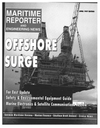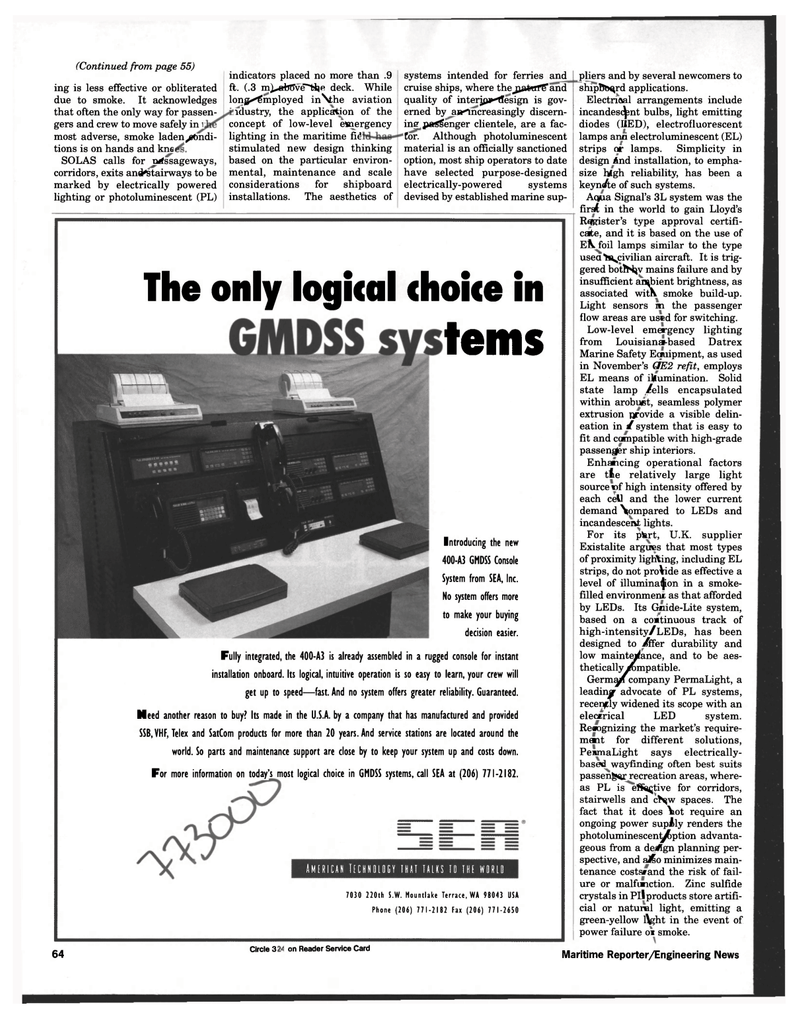
Page 64: of Maritime Reporter Magazine (April 1997)
Read this page in Pdf, Flash or Html5 edition of April 1997 Maritime Reporter Magazine
AMERICAN TECHNOLOGY IHAI TALKS 10 IKE WORLD pliers and by several newcomers to shipfcb^rd applications.
Electrical arrangements include incandescent bulbs, light emitting diodes (BED), electrofluorescent lamps arm electroluminescent (EL) strips or lamps. Simplicity in design And installation, to empha- size high reliability, has been a keyn/te of such systems.
Aqua Signal's 3L system was the first in the world to gain Lloyd's
Register's type approval certifi- cate, and it is based on the use of
EKfoil lamps similar to the type usea>tsscivilian aircraft. It is trig- gered botfKjv mains failure and by insufficient sm^bient brightness, as associated wit\ smoke build-up.
Light sensors m the passenger flow areas are used for switching.
Low-level emergency lighting from Louisiana-based Datrex
Marine Safety Ecriipment, as used in November's QE2 refit, employs
EL means of illumination. Solid state lamp /ells encapsulated within arobuet, seamless polymer extrusion provide a visible delin- eation in / system that is easy to fit and compatible with high-grade passenger ship interiors.
Enhancing operational factors are tie relatively large light source »f high intensity offered by each ceU and the lower current demand \ompared to LEDs and incandescent lights.
For its pfcrt, U.K. supplier
Existalite argues that most types of proximity lighting, including EL strips, do not provide as effective a level of illuminaljion in a smoke- filled environment as that afforded by LEDs. Its Gnide-Lite system, based on a continuous track of high-intensityVLEDs, has been designed to /ffer durability and low maintenance, and to be aes- thetically^mpatible.
Germ^ company PermaLight, a leadinjf advocate of PL systems, recently widened its scope with an elerarical LED system.
Rerognizing the market's require- mait for different solutions,
PesmaLight says electrically- based wayfinding often best suits passen^srrecreation areas, where- as PL is efSmjtive for corridors, stairwells and c^qw spaces. The fact that it does \ot require an ongoing power supily renders the photoluminescen^ption advanta- geous from a dejfign planning per- spective, and aJio minimizes main- tenance cost^and the risk of fail- ure or malfiMiction. Zinc sulfide crystals in Pllproducts store artifi- cial or natural light, emitting a green-yellow lV?ht in the event of power failure 01 smoke. (Continued from page 55) ing is less effective or obliterated due to smoke. It acknowledges that often the only way for passen- gers and crew to move safely in 1 most adverse, smoke laden^mdi- tions is on hands and kne
SOLAS calls for Mfssageways, corridors, exits and^stairways to be marked by electrically powered lighting or photoluminescent (PL) indicators placed no more than .9 ft. (.3 mj^ataffvfTtije deck. While long^€mployed inVhe aviation
Klustry, the application of the concept of low-level einergency lighting in the maritime fit? stimulated new design thinking based on the particular environ- mental, maintenance and scale considerations for shipboard installations. The aesthetics of systems intended for ferries and cruise ships, where thejaa^wTtfand quality of interjp*-llesign is gov- erned bya»^mcreasingly discern- inepasSSenger clientele, are a fac- tor. Although photoluminescent material is an officially sanctioned option, most ship operators to date have selected purpose-designed electrically-powered systems devised by established marine sup-
The only logical choice in tems
Introducing the new 400-A3 GMDSS Console
System from SEA, Inc.
No system offers more to make your buying decision easier.
Fully integrated, the 400-A3 is already assembled in a rugged console for instant installation onboard. Its logical, intuitive operation is so easy to learn, your crew will get up to speed—fast. And no system offers greater reliability. Guaranteed.
Need another reason to buy? Its made in the U.S.A. by a company that has manufactured and provided
SSB, VHP, Telex and SatCom products for more than 20 years. And service stations are located around the world. So parts and maintenance support are close by to keep your system up and costs down.
For more information on today's most logical choice in GMDSS systems, call SEA at (206) 771-2182. 7030 220th S.W. Mountlake Terrace, WA 98043 USA
Phone (206) 771-2182 Fax (206) 771-2650 64 Circle 318 on Reader Service Card Maritime Reporter/Engineering News

 63
63

 65
65
